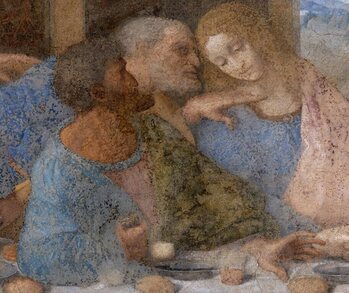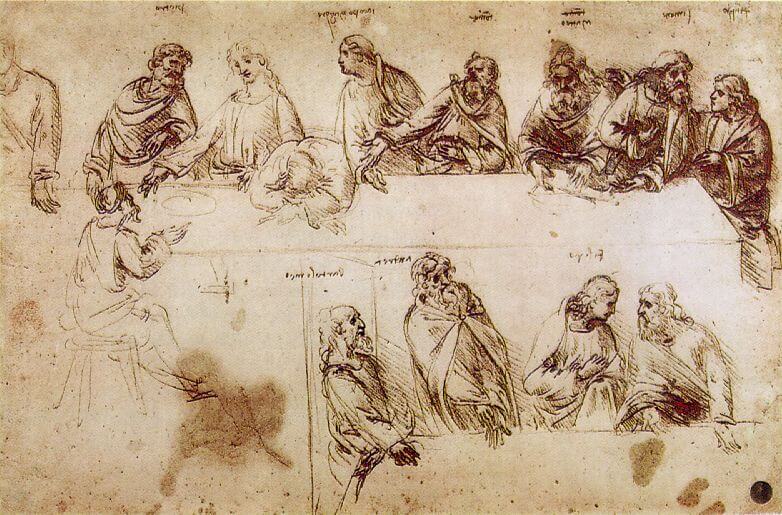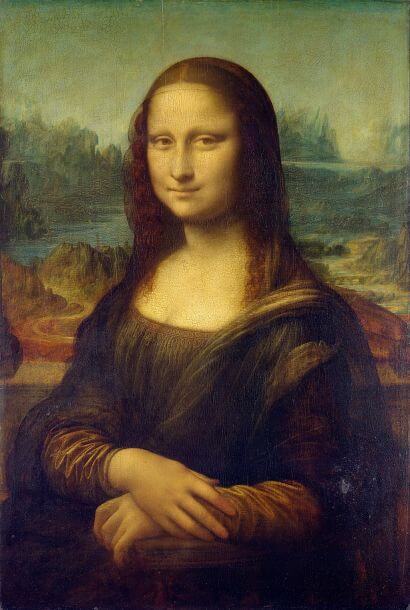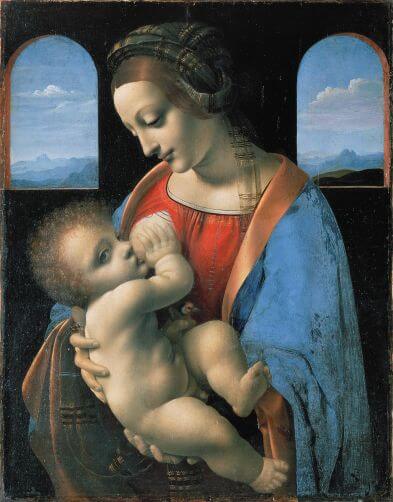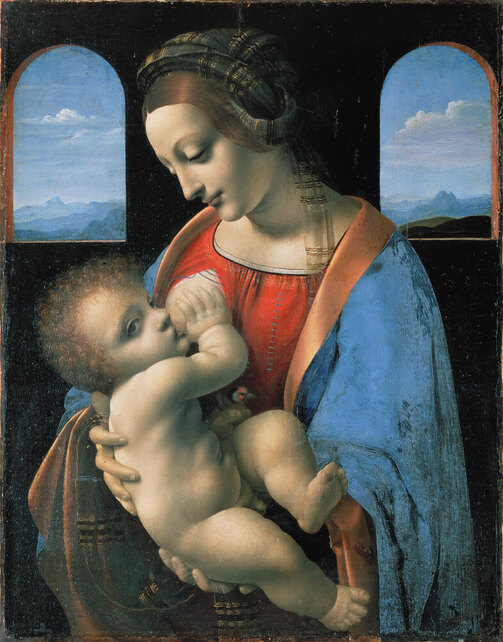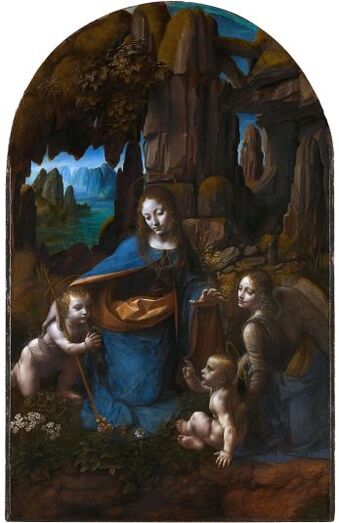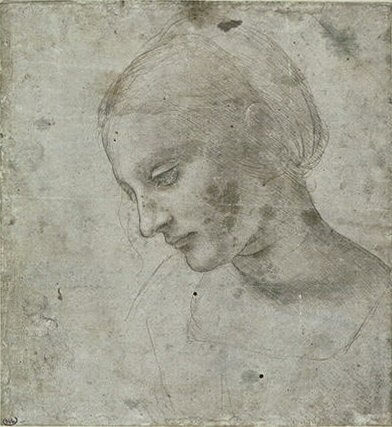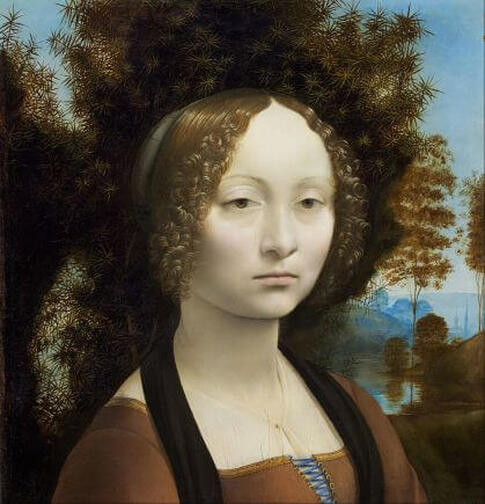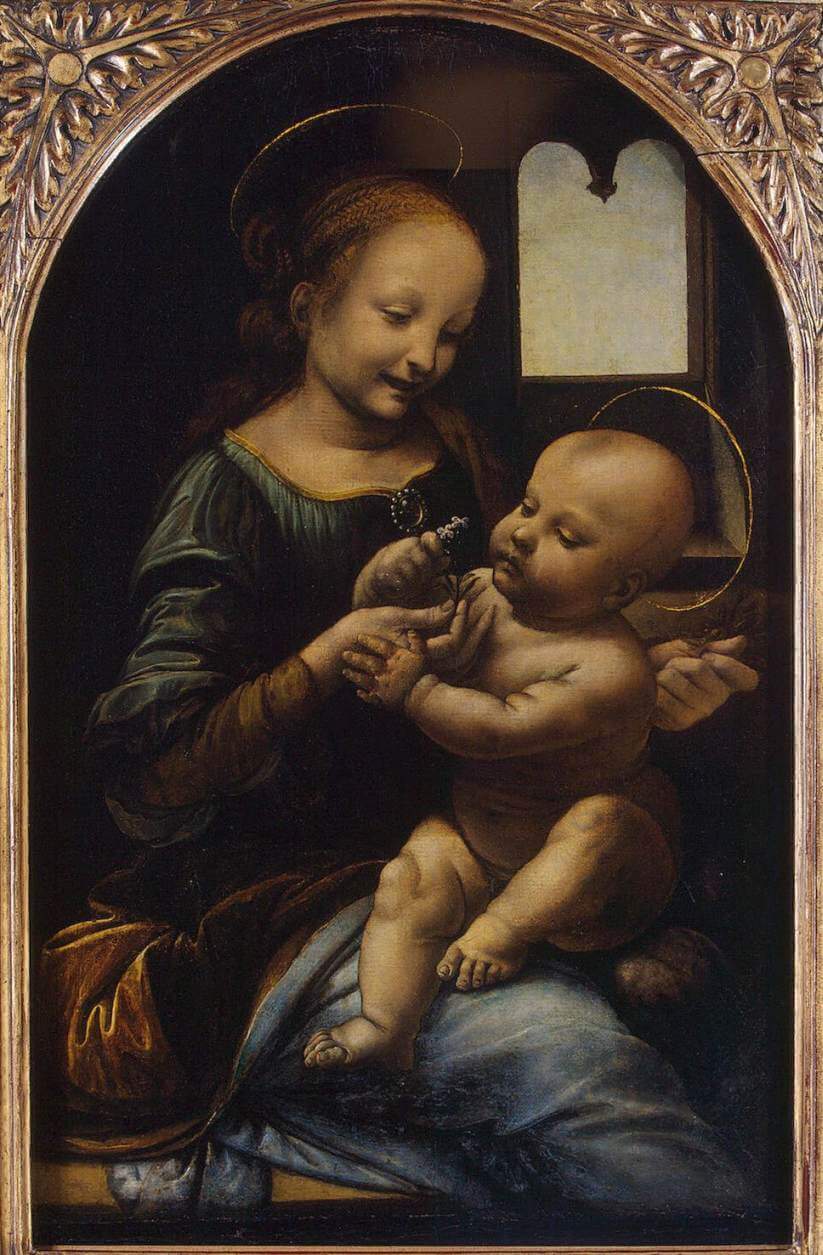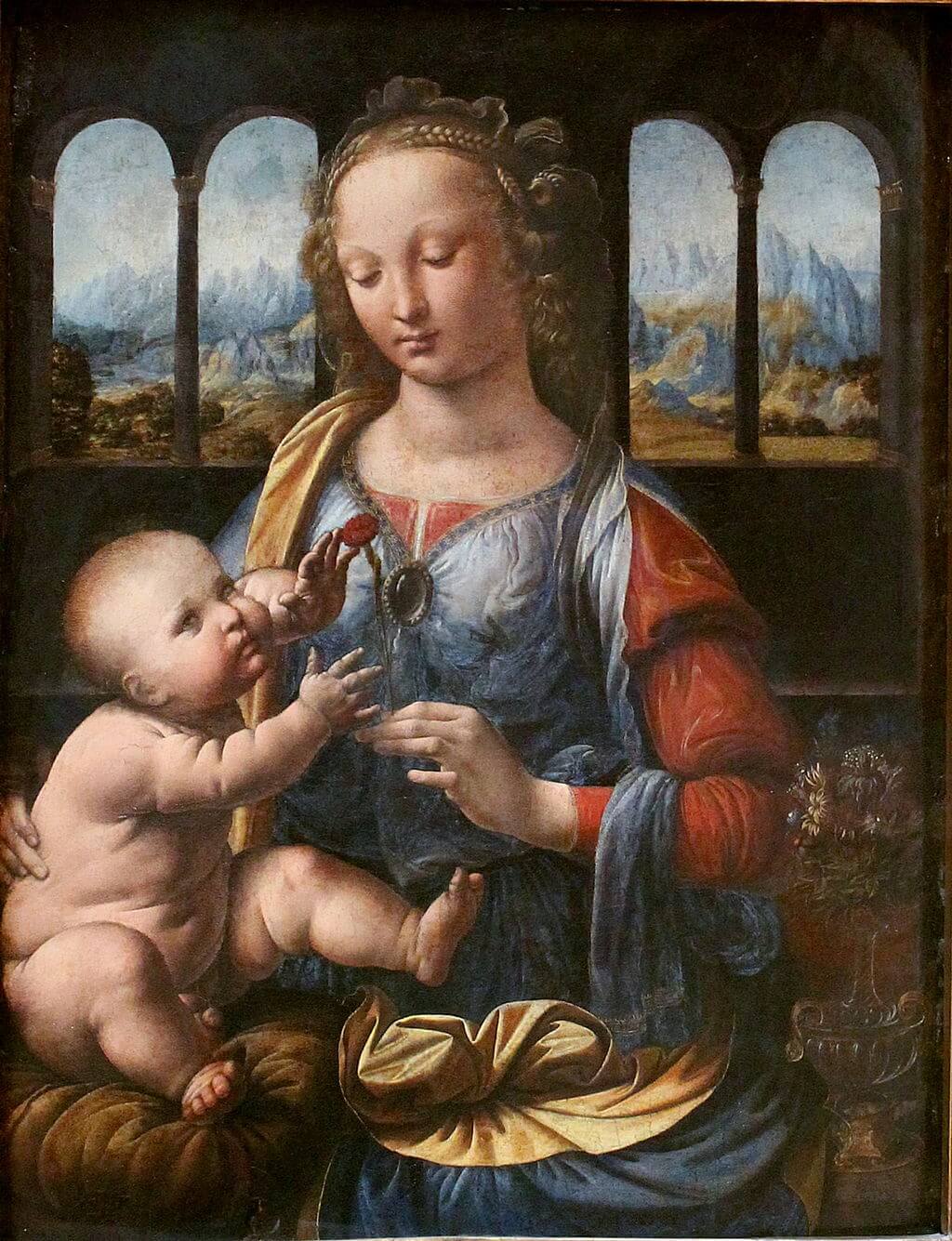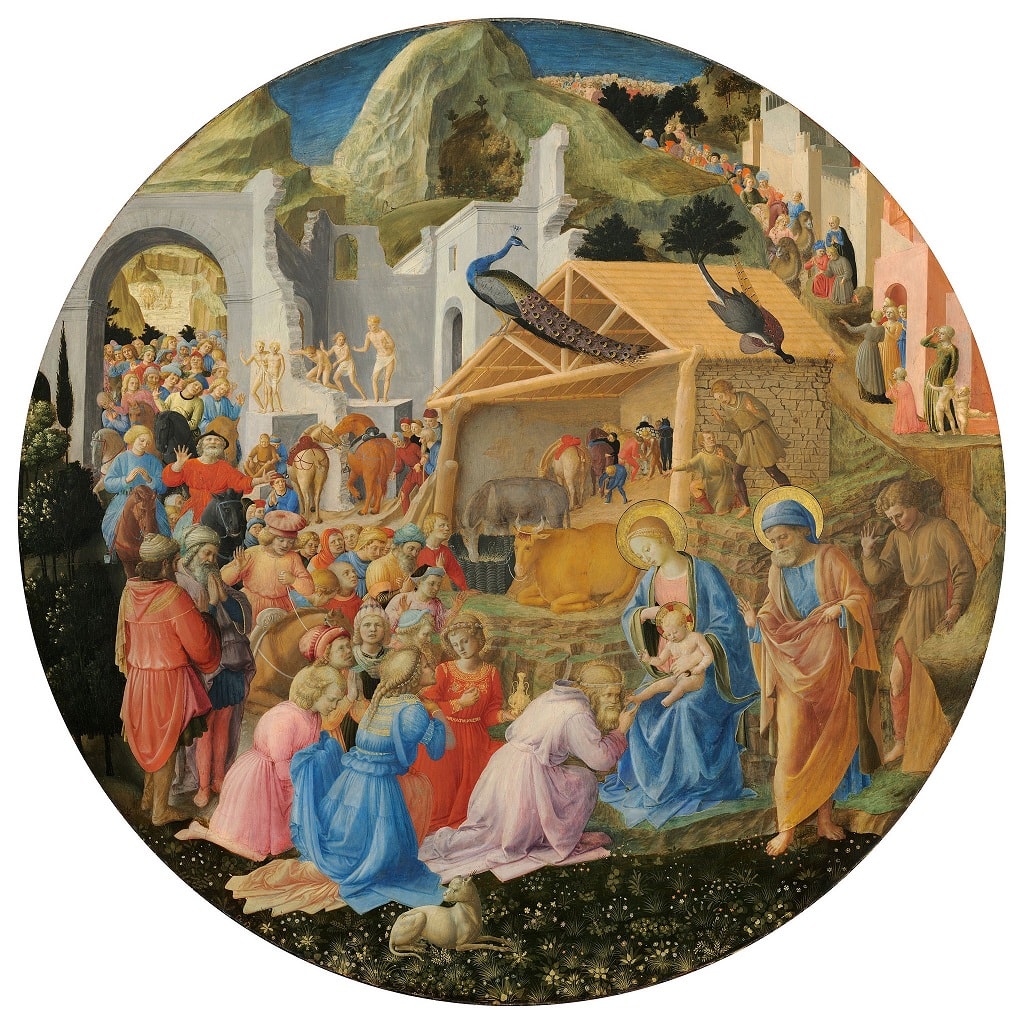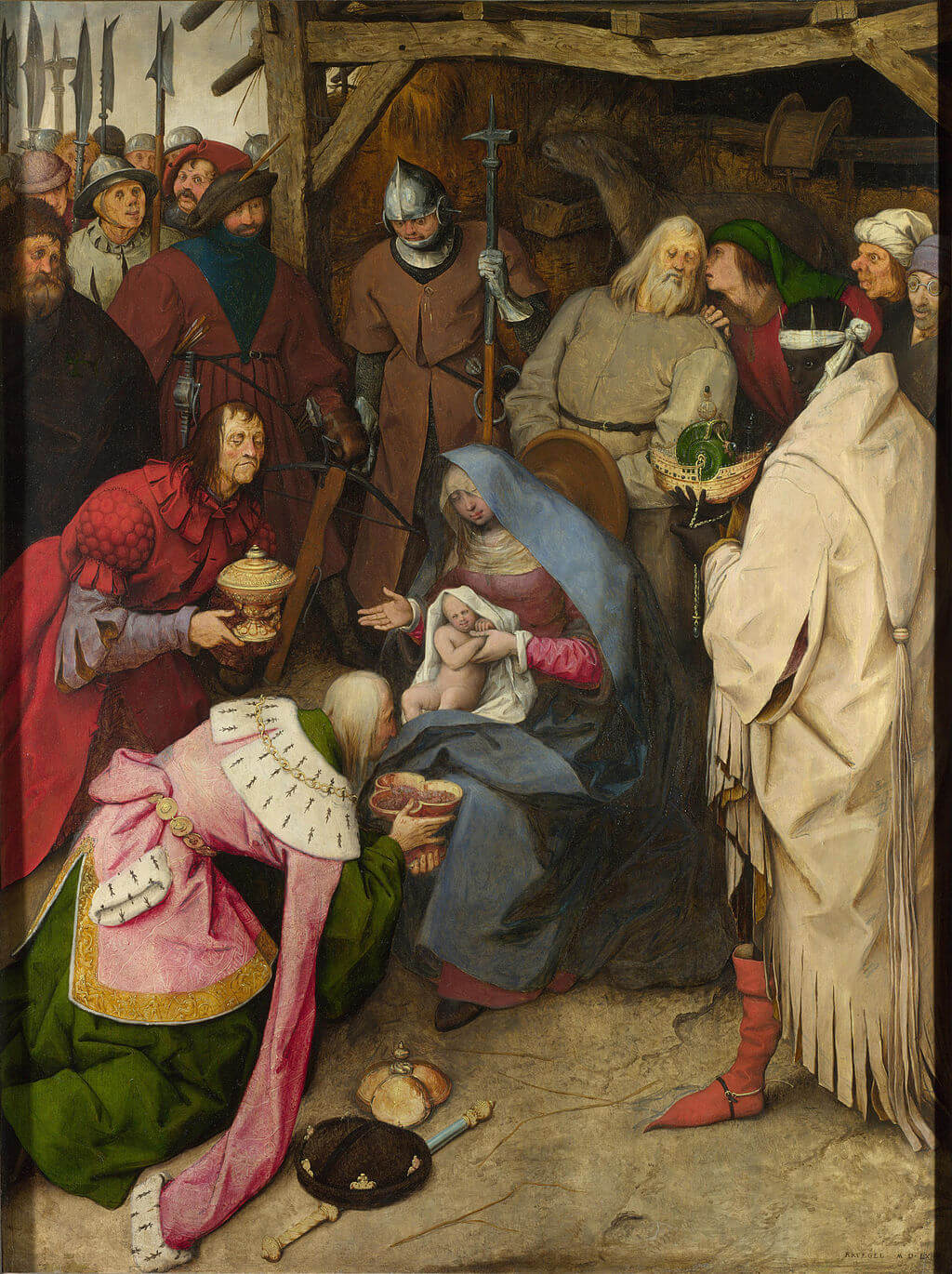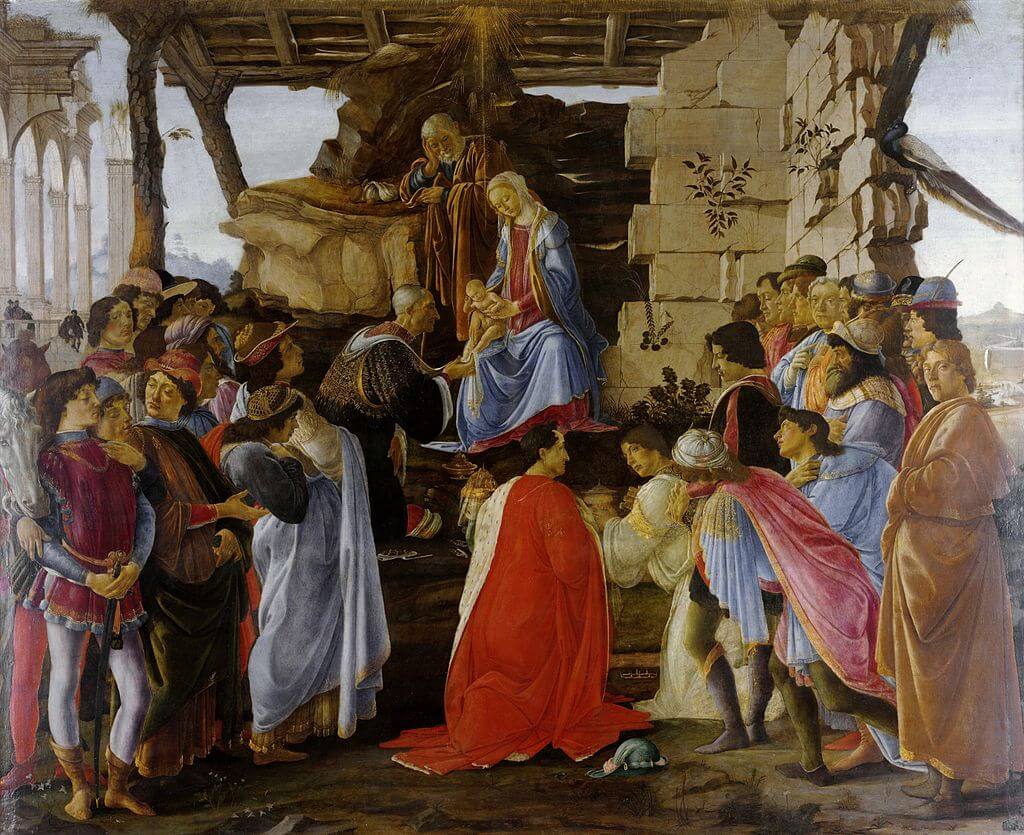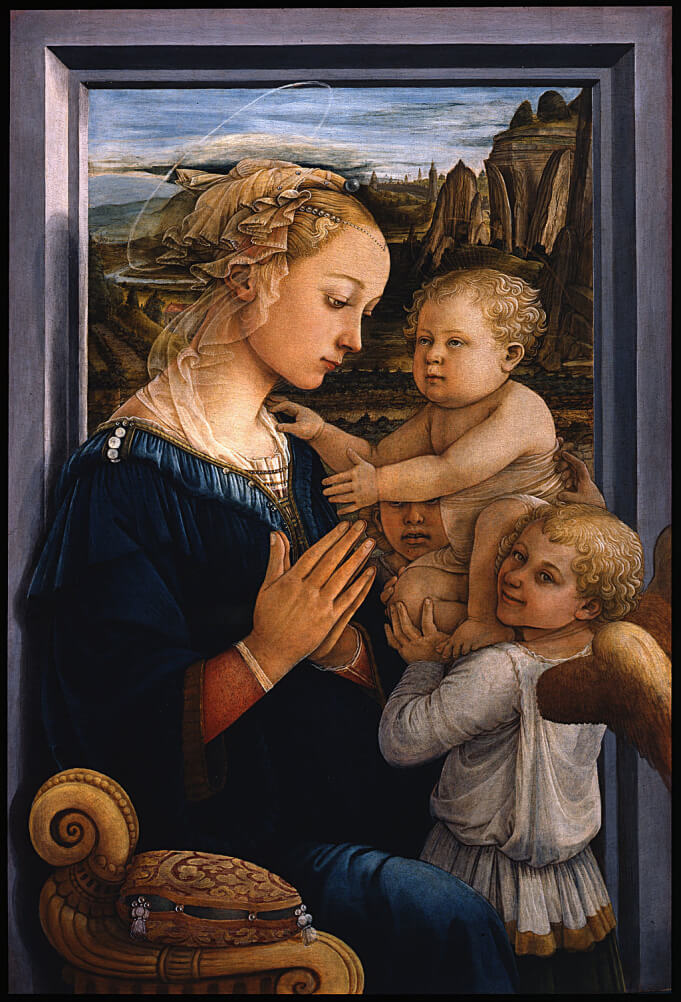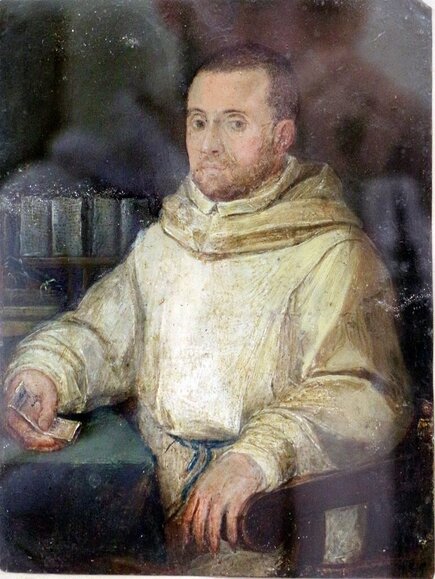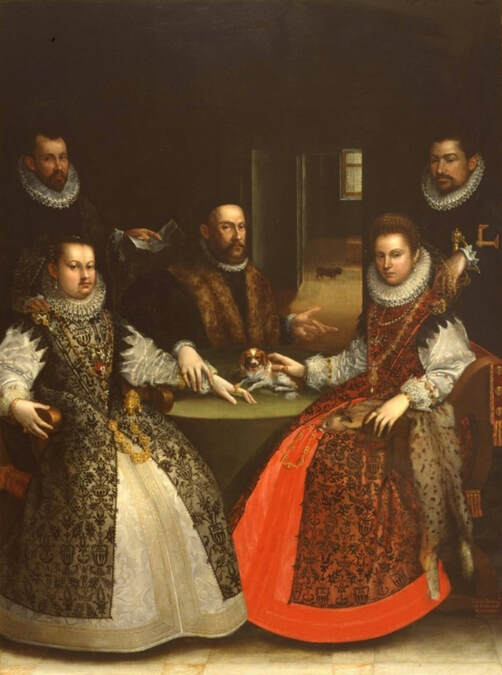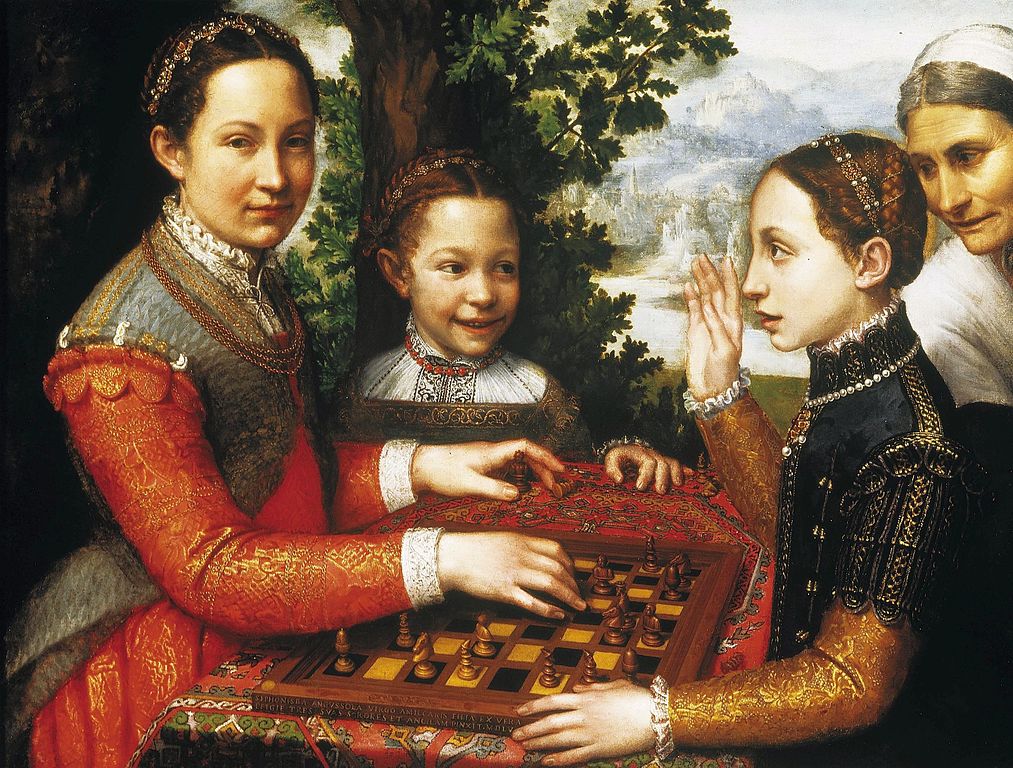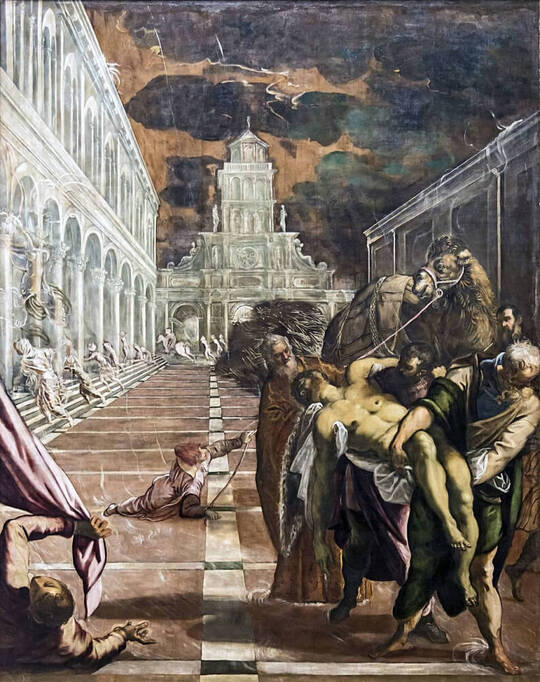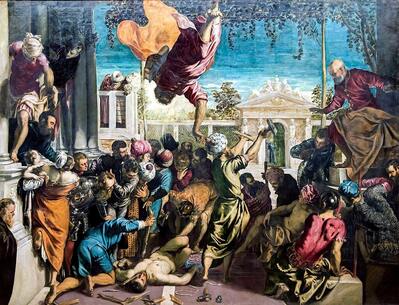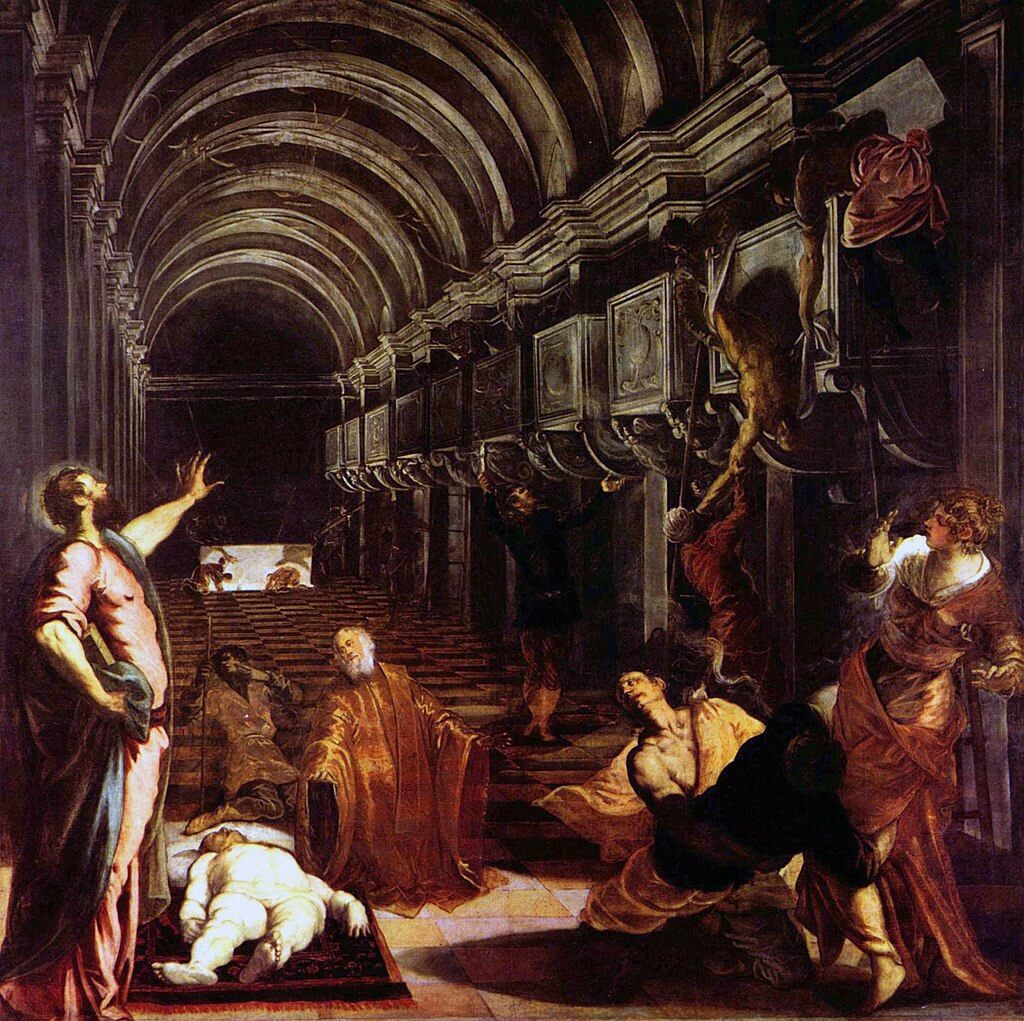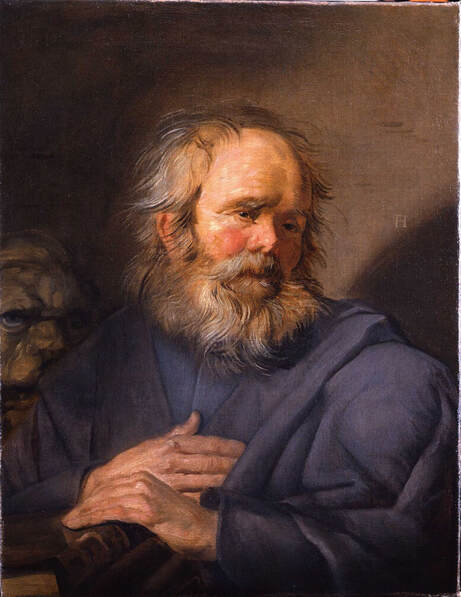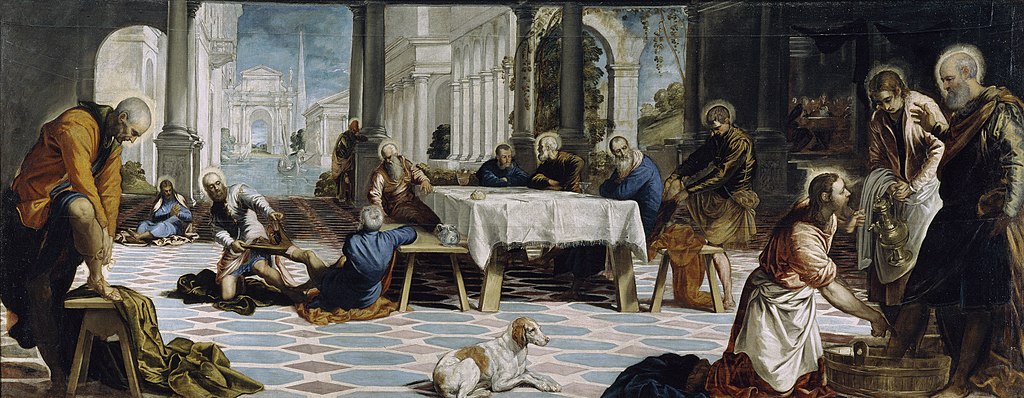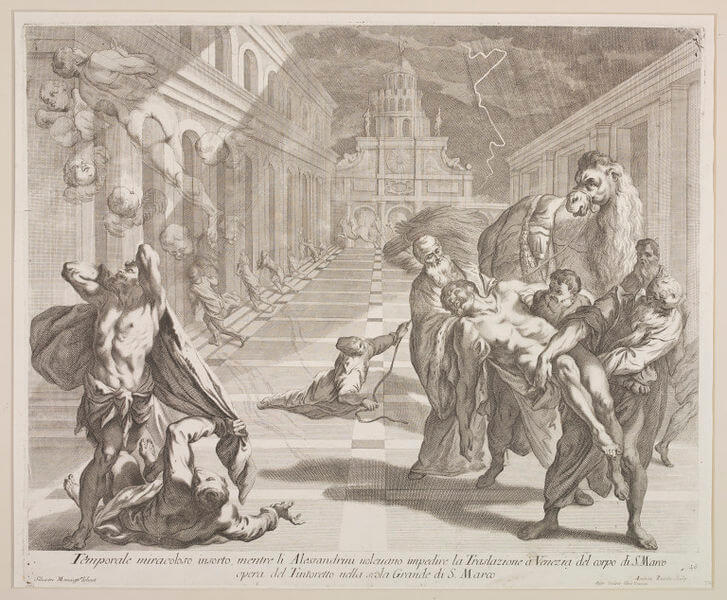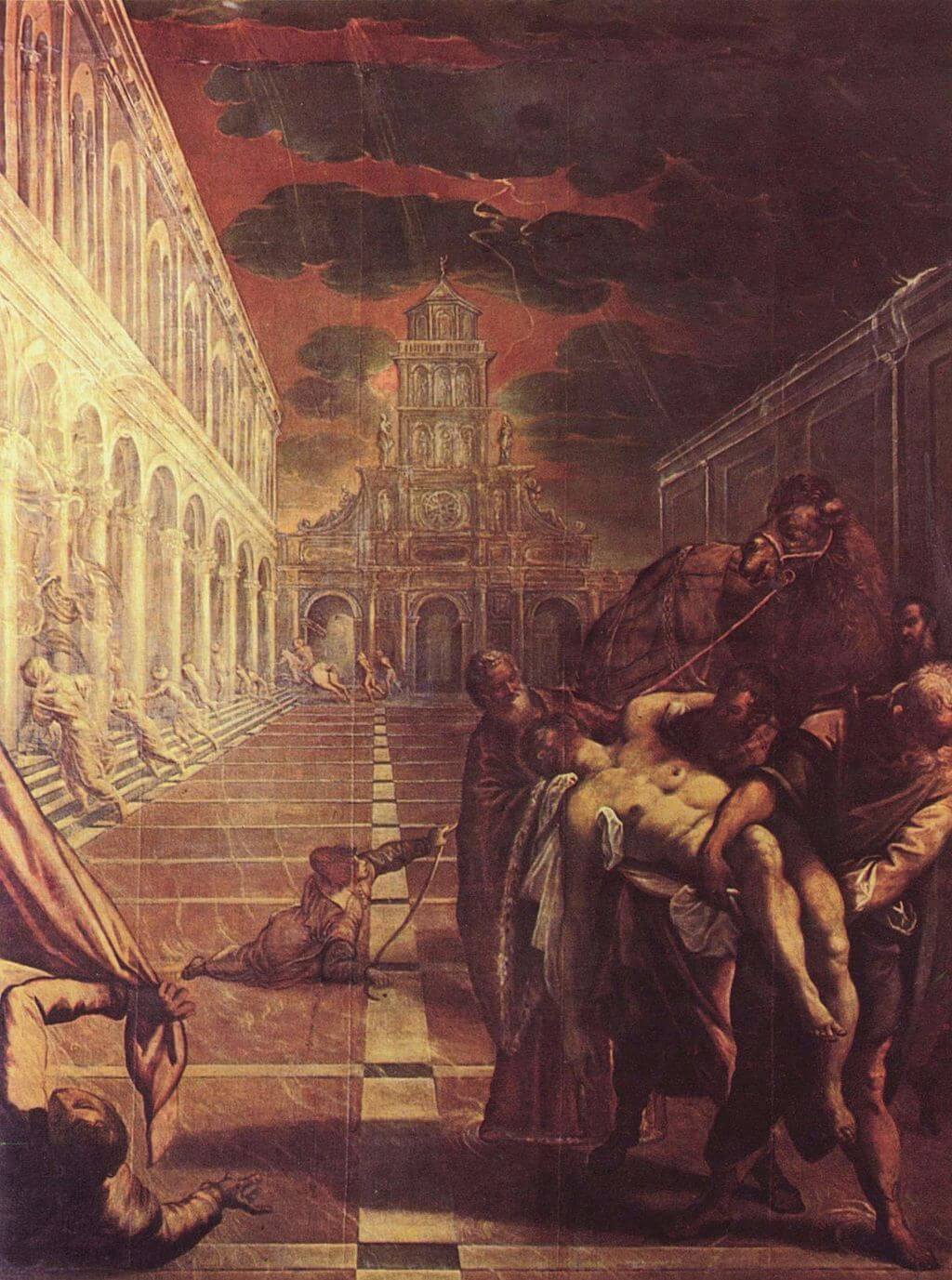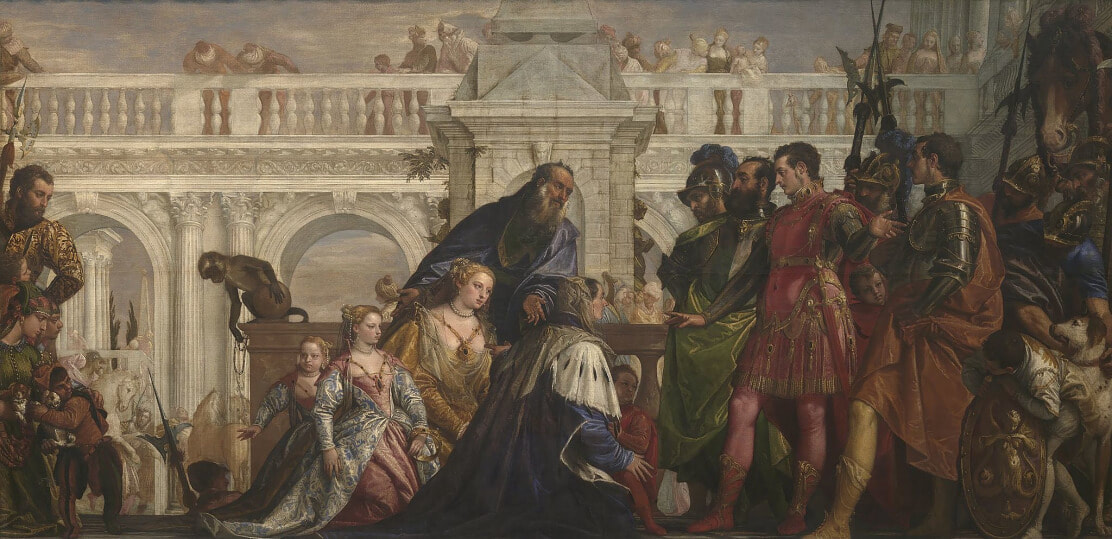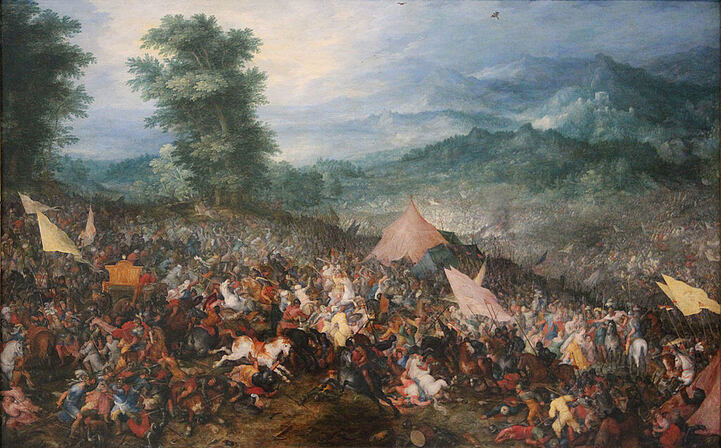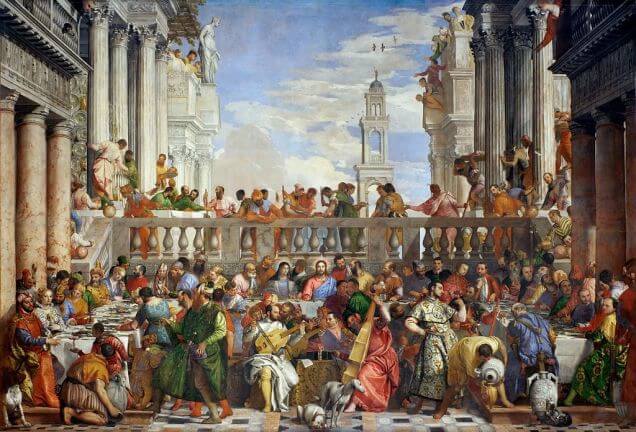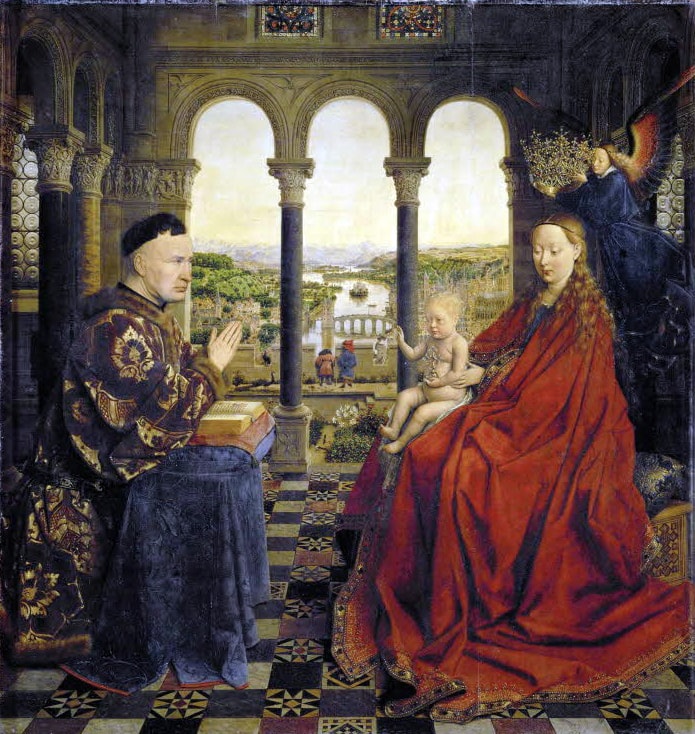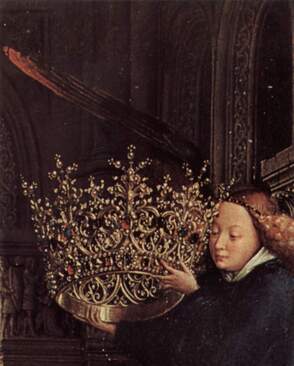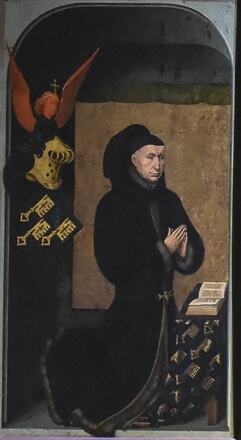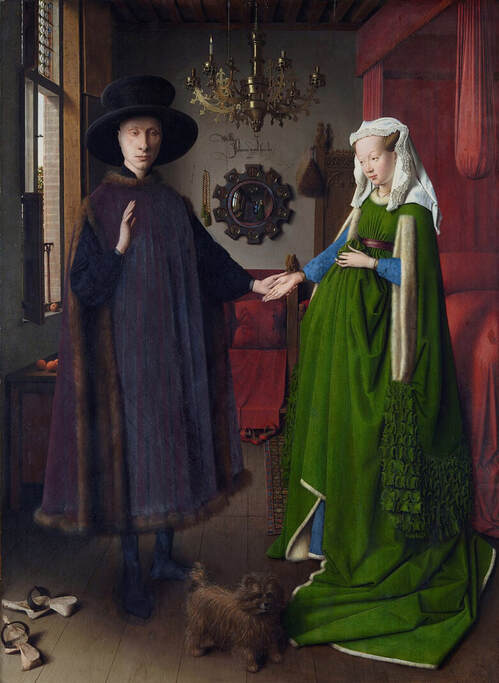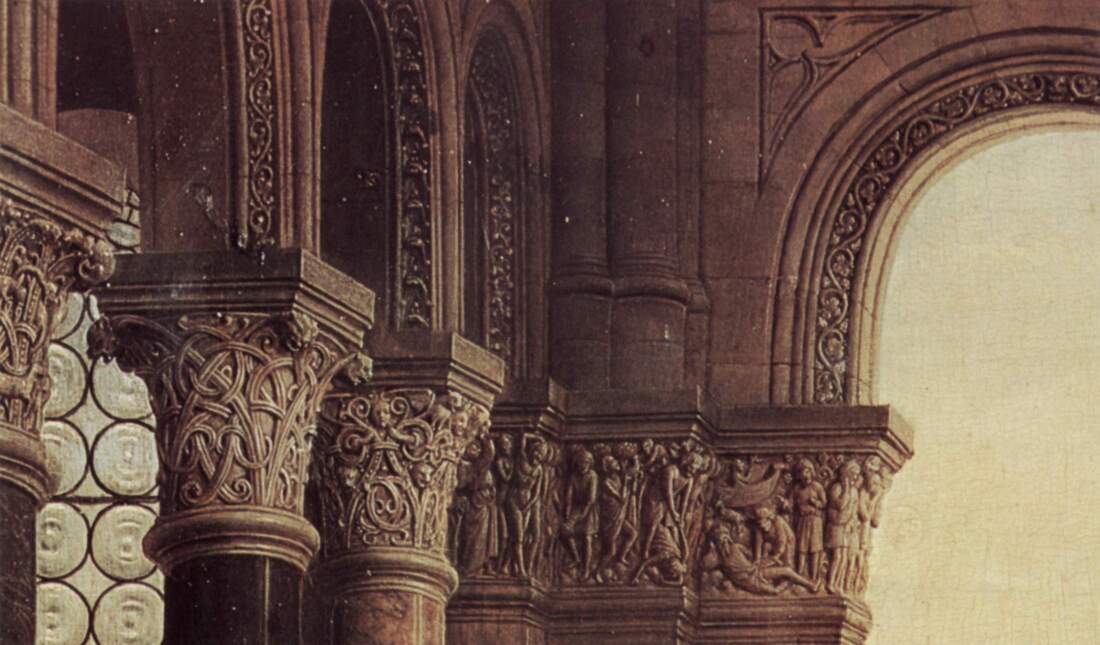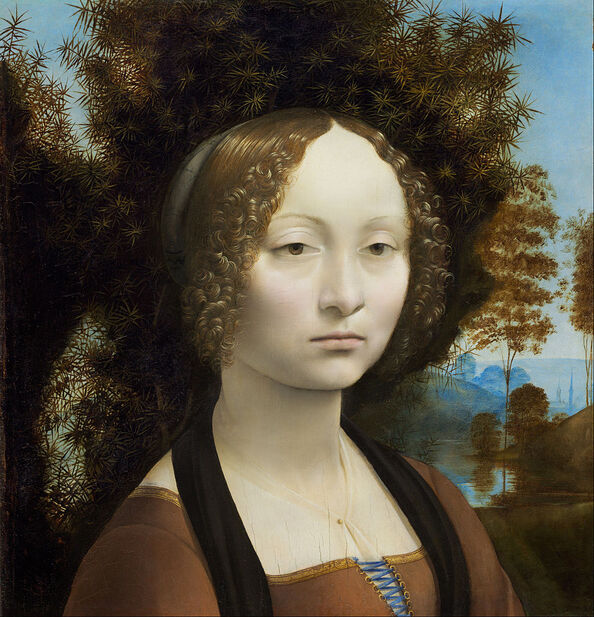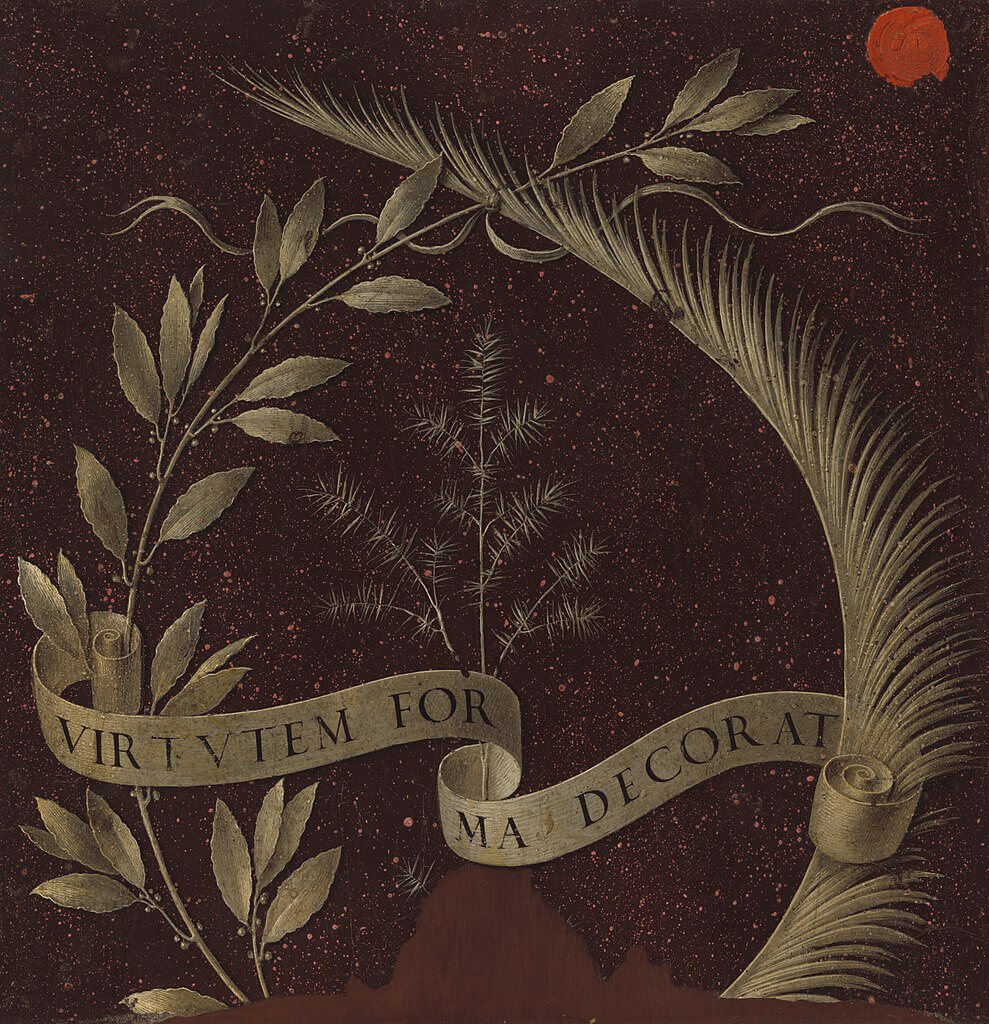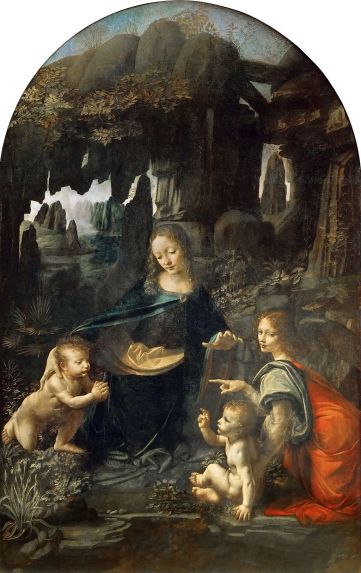|
Where? Santa Maria delle Grazie Dominican Church and Convent in Milan
When? 1495-1498 Commissioned by? Ludovico Maria Sforza, Duke of Milan between 1494 and 1499, for the renovations he had planned for the church and convent. What do you see? The Last Supper where Jesus and the 12 apostles are sharing their final meal before the crucifixion. The fresco is designed so that the space in which the last supper takes place looks like an extension of the architecture of the room itself. In the center is Christ. His outstretched arms touch the table. The 12 apostles are divided, first into two groups of six on each side, and second, into subgroups of three. Each subgroup is a tightly-knit group in composition. Scan the row of heads and see the wave-like arrangement, surging and ebbing.
The ceiling of the room is painted as if coffered, and the coffers provide a clear sense of depth to the mural. In the background are three windows with a view to the landscape. The center window behind Christ, has a semicircular pediment, suggestive of a halo. The right wall is illuminated and the left is in shadow.
Backstory: Leonardo da Vinci always carried a sketch book with him. He looked for facial expressions, bodily movement, and believed the artist had “two principal things to paint, man and the intention of his mind.” He has frozen these 13 men in a moment of time and by doing so, he captured all the drama and excitement of the Gospel verses in The Last Supper. Few sketches remain but below is an early version.
Da Vinci had indicated great concern about painting Christ’s face. Christ is larger than the others (hierarchical perspective) and this is also of theological importance. The spatial isolation of Jesus gives added importance to his image. Da Vinci also used the most expensive paint for Christ—ultramarine.
It is hard to imagine the reactions of the friars and nuns as they entered the refectory to see the mural for the first time (before the mural started to deteriorate). The light, bright, stunning colors of a well-known story told in a brand-new fashion must have been almost shocking. Gone were the traditional halos, the flat facial expressions, the formalism, and instead, a band of 13 young men are seen reacting to an announcement that none of them could believe would happen. The humanism of Da Vinci was a great surprise. In the silence of their shared meals it must have given them much to contemplate. Restoration: Leonardo da Vinci had no experience painting frescos before he started on this mural and used an experimental technique similar to painting on a wooden panel. As a result, the painting is in very poor state as Da Vinci painted on an outside wall with no space to prevent water damage, and he painted with a mixture of oil paint and tempura. The paint did not adhere to the wall and it was decaying even during Da Vinci’s lifetime. Numerous restoration attempts have been made over the centuries, but they usually caused further problems. In 1979, a small group of Italian art restorers began a huge project to properly do the job. It took them 20 years to complete. Symbolism: Christ’s simple pose is complex in detail and meaning—he is silent, sad, and submissive. His right hand extends toward Judas, whose hand is near his. Christ’s hand is palm down, accusing Judas. “The hand that betrayeth me is with me on the table.” At the same time, Christ’s right hand refers to the glass of wine, the symbol of his blood used in the Mass, while his left hand extending to the bread refers to the symbol of his body. The triangular pose of Christ is a reference to the Holy Trinity, an emblematic abstraction of his words, “He who has seen me has seen the Father.” The hand with the forefinger pointing straight upward to the right of Christ, belongs to Thomas. His probing finger refers to the physical resurrection of Christ and points to heaven as a harbinger of the physical ascension. Refectory of Santa Maria delle Grazie: The Last Supper measures 460 cm x 880 cm (15 ft x 29 ft) and covers the end wall of the refectory (dining hall) of the monastery. Painting the mural was not easy and a hazardous task as it was placed 15 feet above the floor. The theme of the Last Supper was a traditional one for refectories. The opposite wall of the refectory is covered by the Crucifixion fresco by Giovanni Donato da Montorfano, to which Leonardo da Vinci added figures of the Sforza family in tempura; these figures have deteriorated in much the same way as those in The Last Supper. Da Vinci worked very thoroughly but slowly and Montorfano was finished before him, to the consternation of Duke Sforza who exhorted Da Vinci to finish his project.
Who is Da Vinci? Leonardo da Vinci was born April 15, 1452 near Vinci in Tuscany. He was the illegitimate son of a 25 year old aspiring lawyer/notary, who had come home for the summer and met the young peasant girl Caterina. He was already engaged to be married but these occurrences were not particularly remarkable at that time.
His paternal grandfather took custody of Leonardo after the birth. The fact that Leonardo was not a legitimate son may have been quite fortunate, as the first legitimate son would have had to follow in his father’s footsteps and become a lawyer. His grandfather allowed him free reign to pursue other interests. When Leonardo was 15 years old, he was sent to Florence to work as an apprentice to Andrea del Verrocchio. He excelled and by the time he was 25, he had his own studio with students. He applied to the Duke of Milan and moved there when he was 30. In 1499, following the Duke’s fall from power, he left Milan and spent a short time in Venice. He returned to Florence in 1500 and in 1516 he moved to France at the invitation of King Francis I. He died there in 1519 at age 67. Among his most famous works are the Mona Lisa in the Louvre and the Madonna Litta in the Hermitage Museum.
Fun fact: The rules of perspective that were used, bring about an unusual effect. This is especially true when looking at the table. The top of the table is always visible, no matter the angle at which you look at the painting. The nuns and friars in the refectory would be sitting well below the mural and it was important that they could see the bread and wine in this fresco.
Another interesting aspect of the fresco is the bottom center of the mural, where a doorway has been cut into the painting. In 1652, the kitchens were relocated to the room behind the refectory and they wanted easier access to the room. They cut out a good portion of the painting, included the feet of Jesus. Fortunately, in 1520, Giampietrino had made a copy of the original in oil on canvas. We can see Jesus’ feet and also the salt cellar spilled by Judas that is no longer visible in the original fresco by Da Vinci. This copy by Giampietrino was very important for the restoration of The Last Supper between 1979 and 1999.
1 Comment
Backstory: This painting is called the Madonna Litta because of a previous owner of the painting, the art collector, count Antonio Litta, from Milan, Italy. Tsar Alexander II acquired this painting in 1865 for the Hermitage Museum.
It is not known when Leonardo da Vinci made this painting exactly as he liked to do multiple projects at once and he often took a long time to complete a painting. What is known is that, in 1479, he already completed the first sketch of a nursing Madonna (now in the Royal Library at Windsor, England). After that, he completed more preparatory works for this painting, including a sketch of the face of Mary which is now in the Louvre. It is assumed that Leonardo started this painting in 1481 and that he stopped working on it for a while because of other commissions.
Symbolism: The scene of the Virgin Mary breastfeeding Baby Jesus shows motherhood and motherly love. The blue mantle of Mary symbolizes the Church and her red dress is a symbol of the passion of Christ. The goldfinch is a symbol of the future crucifixion of Jesus. The mountain landscape in the background represents the greatness of the Creation of the world by God.
What is Madonna Lactans? The Virgin Mary breastfeeding Baby Jesus is the perfect example of motherly love. This theme is referred to as Madonna Lactans or Nursing Madonna. Madonna Lactans has been the subject of quite some paintings from the 12th century until the middle of the 16th century when the Council of Trent discouraged the use of nudity in religious paintings. Madonna Lactans was also a frequent theme in the Orthodox Art in Russia, and this theme is better known as Mlekopitatelnitsa. This may explain why the Russian Tsar Alexander II bought this painting for the Hermitage Museum. Who is Leonardo da Vinci? Leonardo di ser Piero da Vinci (1452-1519) was an expert in a large number of different fields, including astronomy, geology, mathematics, music, and painting. He was born in Vinci, near Florence, and received his artistic education in the workshop of Andrea del Verrocchio. During that time, he already created Ginevra de’ Benci, which is in the National Gallery of Art in Washington, DC. After he finished his apprenticeship with Verrocchio in 1478, he moved to Florence, and in 1482 he moved to Milan where he stayed until 1499. There he worked on many different projects, and he often moved on to the next project leaving the previous one unfinished. Over the next decade, he lived in several different places in Italy. During this time, he created his famous Mona Lisa.
Fun fact: There is a lot of debate whether this painting should be attributed to Leonardo da Vinci or one of his assistants. In 1482, Leonardo mentioned that he had completed one Madonna (probably the Benois Madonna, which is also in the Hermitage Museum) and had almost finished another one. This other Madonna can either be the Madonna Litta or the Madonna of the Carnation, which is in the Alte Pinakothek in Munich.
The main reason that people doubt whether this painting is entirely created by Leonardo is the plain landscape, the somewhat dull outfit of Mary, the shadows in this painting, and the lack of details in her face (compare this to Leonardo’s drawing in the Louvre above). People argue that these aspects are not of the quality that we could expect from Leonardo. However, experts agree that the design of the painting and especially the complicated pose of Mary and Baby Jesus could well be from Leonardo. So, it is not unlikely that Leonardo has started this painting, but that an assistant, maybe Giovanni Antonio Boltraffio, finished the painting. Interested in a copy for yourself? Poster.
Where? Gallery 4 of the National Gallery of Art
When? Between 1440 and 1460 Commissioned by? Most likely the Medici family What do you see? This tondo in a gold frame shows hundreds of people lining up to worship Baby Jesus. The line starts at the top right of the painting, goes around the back of the stable and the white building, and continues on the left side of the painting where people are entering under the arch. On the bottom right, the Holy Family is depicted. The Virgin Mary is wearing a blue dress and has Baby Jesus on her lap. You can see some pomegranate seeds next to the left hand of Jesus. To Mary’s right is Saint Joseph. To their left, you can see the typical donkey, ox, and manger. Behind and to the right of Mary and Joseph, you can see the three shepherds present at the birthplace of Jesus. In front of the line of people are the three Magi (also known as the three wise men or three kings) and behind them is their following. The first Magus is kneeling down in front of Jesus and touches his right foot. Jesus raises his right hand to bless him. The other two Magi are waiting behind him. The horses of the Magi are taken care of in the stable. Next to the stable is a group of blind and disabled people. Above them is a white architectural structure in decay and on top of this structure stands a group of five almost naked people. The painting contains various animals, such as cows, horses, camels, a donkey, an ox, a falcon, a peacock, a pheasant, and a dog. The two birds on the right of the stable probably represent a falcon (or a goshawk) attacking a pheasant. On the top right, next to the mountaintop, you can see even more faces cluttered together. Also, below the arch on the left, you can see sketches of more people and animals. Backstory: This painting is also known as the Washington Tondo or the Cook Tondo (named after a former owner of the painting). Fra Angelico started this painting, but before completing it, he was called to Rome by the Pope to complete several commissions in the Saint Peter and the Vatican Palace. Fra Filippo Lippi was then commissioned to finish the painting. In addition, it may be the case that several people in the workshops of both friars may have contributed to the painting. It is not entirely clear who painted which parts of the painting. The general idea is that Fra Angelico painted the figures with the thinner faces (like Mary) and Lippi painted the figures with the broader faces (like Saint Joseph and the Magus holding the foot of Jesus). It is thought that Filippo Lippi completed the majority of the painting. Symbolism: The painting contains various symbolic references:
Why the Adoration of the Magi? This theme was popular among Renaissance painters and has been painted by, among others, Botticelli, Pieter Bruegel the Elder, and Leonardo da Vinci. For example, Adoration of the Kings by Bruegel can be found in the National Gallery in London and Adoration of the Magi by Botticelli can be found in the Uffizi Museum in Florence. An important argument for the popularity of the adoration of the Magi theme is that artists could paint the luxury and colorfulness of the costumes of the Magi and their followers. This theme reflects the biblical story in Matthew 2 about the three kings who traveled a large distance following a big star to worship Baby Jesus. They brought three gifts for Jesus: gold, frankincense, and myrrh.
Who is Fra Angelico? Born as Guido di Petro around 1395, he was better known as Fra Angelico or Il Beato Angelico. He lived a very pious life and died in 1455. He started his career as a manuscript illustrator and moved on to become a painter of frescos and paintings.
He was beatified in 1982 by Pope John Paul II, because of his pious life and the amazing quality of his paintings. He was especially good in painting the most beautiful depictions of the Virgin Mary. One of his great works is the Coronation of the Virgin in the Uffizi Museum. Who is Filippo Lippi? Fra Filippo Lippi (1406-1469) was born in Florence. After his parents died and his aunt could not take care of him anymore, he was sent to a Carmelite convent. Unlike Fra Angelico, he lived a far-from-pious life, though he officially remained a friar throughout his life. He left the convent at age 26 and later in his life he even married and got a child, the well-known painter, Filippino Lippi. The Medici family recognized the talents of Filippo Lippi, and during his career, he completed at least nine paintings for them. One of his most famous works is the Madonna and Child with Two Angels in the Uffizi Museum.
Fun fact: An analysis by the National Gallery of Art has revealed that this painting was created over an extended period of time. It also seems that some of the animals in the painting were not initially included in the design, but only added later on, possibly by another painter than Fra Angelico and Filippo Lippi.
Analysis revealed, specifically, that the peacock, falcon, pheasant, and hunting dog were added on top of areas that were already painted. This was probably under the influence of the Medici brothers Piero and Giovanni. Note that the birds are painted bigger than they should realistically be, compared to the rest of the painting, to emphasize their symbolism. They distract the viewer from the real theme of the painting. Interested in a copy for yourself? Poster or canvas.
Where? Ravenna Art Museum
When? 1570 or 1573 Medium: oil on copper, 16.5 x 13 cm. What do you see? The monk looks out with eyes that draw our attention. He appears stern and sober, and his short beard may indicate that he is relatively new to the order. He wears a blue waistband and holds a piece of paper in his right hand. The paper's content is largely illegible, but just below his thumb, we can identify some text reading "157.". It refers to the year this work was painted, but the last digit is hard to read. The books at the end of the table and on the shelf behind him are indicative of his education and knowledge, which would have been deeply respected.
Where? Pinacoteca Nazionale, Bologna
When? 1584 What? Oil on canvas, 250 x 189 cm (8.2 x 6.2 feet) Commissioned by: Laudomia Gozzadini Introduction: At first glance, one could easily pass by this portrait as yet another family using fancy clothes and jewelry to tell the world how important and influential they are, however, it would be a mistake to miss this. The painting exposes a dysfunctional family, 16th century style. Knowing who the people are and their backstories is the best way of interpreting the messages that the commissioner of the painting, Laudomia Gozzadini wished to include in her family portrait. She and Lavinia Fontana shared extremely intimate information in order for the artist to paint this artwork. It is a collaboration that is palpable in the painting.
Where? National Museum in Poznań
When? c. 1555 What do you see? Three of Sofonisba Anguissola’s younger sisters at a table in a grand setting, playing a chess game. They are observed by the family housemaid on the top right. It not only provides a glance at some of Sofonisba’s younger sisters who also studied painting at that time, but also showcases the sophistication of the Anguissola family, an aspect that is further emphasized by their luxurious clothing and jewelry. The painting shows how the oldest of the three portrayed sisters, Lucia, has made the decisive move to win the game. We can see how she holds the black queen in her left hand, indicating that she has defeated her sister. Her younger sister Europa, on the right, has to concede and shows her admiration by looking at her older sister. The youngest of the three, Minerva, grins at Europa to see her reaction. The Chess Game is a lively scene expressing the interactions between the sisters through their facial expressions, and the oldest sister engages the viewer by directly looking at us, as if asking for some praise for her achievement. And the nurse is still contemplating the sequence of moves that had led to the victory.
Where? Room 10 of the Gallerie dell’Accademia
When? 1562-1566 Commissioned by? Tomasso Rangone, a Venetian patron of the arts and the Guardian Grande of a large confraternity in Venice. What do you see? Three people carry the dead body of Saint Mark. The person in the brown robe, holding the head of Saint Mark, is the commissioner of this painting, Tomasso Rangone. The bearded man to the right of dromedary is Tintoretto. In the background is a woodpile on which the body of Saint Mark was supposed to be burned and from which the Christians in this painting stole Saint Mark’s body. The sky in the background is red and dark and contains a lightning strike. The sky refers to the hailstorm that came down at the moment that the killers of Saint Mark wanted to burn him on the pyre. In the left foreground lays a man pulling a cloth. In the original painting, this man was fighting with another man over this a protective cloth of Saint Mark. However, this part of the painting has been cut off. Behind the scene on the body of Saint Mark, there is a dromedary that escaped from his owner who lays on the ground holding on to the leash. It may be a symbolical reference to the death of Saint Mark as a martyr, but this is not entirely clear. Perspective: Tintoretto used linear perspective in this painting which becomes clear when looking at the buildings and the white limestone on the floor. He matched the colors in this painting to emphasize this perspective. The colors in the foreground are darker than those in the background. He painted the people in the foreground in dark colors and the smaller people in the background, who are running away from the thunderstorm, are completely white. Series of Paintings on Saint Mark: This work was commissioned as part of a series of paintings on Saint Mark. The theme of Saint Mark was chosen as Saint Mark is the patron saint of Venice. Tintoretto completed four paintings for the Chapter Room of the Scuola Grande di San Marco. The other three paintings are Miracle of the Slave and Saint Mark Saving a Saracen from Shipwreck in the Gallerie dell’Accademia and the Finding of the Body of St Mark in the Pinacoteca di Brera in Milan.
Backstory: This painting was commissioned for the Scuola Grande di San Marco, a confraternity in Venice. It is known under a variety of names, including: “Saving of the Body of St Mark,” “The Abduction of the Body of St Mark,” “St Mark’s Body Brought to Venice,” and “Transport of the Body of St. Mark.” The last two names incorrectly label this painting as one that deals with the transport of Saint Mark’s body to Venice.
Saint Mark was killed in Alexandria, Egypt, in 68 AD. He was killed in a horrific way. His killers put a rope around his neck and dragged him through the streets until he was dead. The plan was to burn his body. However, right after he was killed and was put on the pyre, there was a hailstorm which caused his killers to flee, and therefore his body could be recovered by fellow Christians. They buried him with great respect in the Church of Alexandria. Interestingly, the scene in this painting is supposed to take place in Alexandria, Egypt. However, the architecture in this painting is quite similar to the Piazza San Marco in 16th-century Venice. Who is Saint Mark? The supposed writer of the Gospel of Mark. He is also the founder of the Church of Alexandria, which was one of the most important churches in Early Christianity. His symbol is a lion, which is illustrated in the painting Saint Mark by Frans Hals in the Pushkin Museum in Moscow. In 828 AD, two Venetian merchants stole his body from Alexandria and transported it to Venice. The Doge of Venice stated in his will to build a basilica for Saint Mark where his body would be buried. This is the famous St Mark’s Basilica on the Piazza San Marco in Venice. In 1063, Saint Mark’s body could not be found anymore, but according to a legend, Saint Mark stuck out his arm from a pillar to reveal the location of his body.
Who is Tintoretto? Jacopo Comin (1518-1594), better known as Tintoretto is one of the three most celebrated painters from Venice; the other being Titian and Veronese. Just like the other Venetian painters, he used beautiful colors in his paintings. The figures he painted were inspired by the Mannerist style as used by Michelangelo.
Tintoretto often painted a group of people in an impressive architectural setting inspired by 16th-century Venice. He also enjoyed developing innovative perspectives. Another example of his style is The Washing of the Feet in the Prado Museum in Madrid.
Fun fact: Until around 1815, the painting was in its original location, the Scuola Grande di San Marco in Venice. Then, Napoleon confiscated it, and pieces from the left and the right of the painting were cut, and two pieces were added to the bottom and the top.
The first picture below shows how the painting looked like originally. You can see that the original painting, for example, contained an image of the transparent body of Saint Mark ascending to Heaven. Several angels support him. On the left side of the current version of the painting, we can still see the feet of Saint Mark’s soul and parts of two angels. The second picture below shows the result after the changes to the painting in the 19th century. In addition to changing the dimensions of the painting, the woodpile was also removed from the painting. Without the woodpile, the painting could be interpreted as the transfer of the body of Saint Mark in 828 from Alexandria to Venice. In 1959, the painting was restored, and the pyre was added back. The pieces that were cut off on the left and right, however, could not be restored. Interested in a copy for yourself? Poster or canvas
Where? Room 9 of the National Gallery
When? 1565-1570 Commissioned by? The Pisano family, probably Francesco Pisani What do you see? This painting is full of activity. The main attention goes to the two groups of life-size people in the foreground. The painting shows how the family of Persian King Darius (in the center) appears in front of King Alexander the Great and his following (on the right) to ask for mercy. The man on the right, dressed in red and gold, is Alexander the Great. To his right, with the orange cape, is his good friend and advisor Hephaistion who is pointing to himself. Alexander is further surrounded by other high-ranked officers in his army, some of which a carrying a weapon called a halberd. The woman in blue in the center foreground is the mother of Darius, Sisygambis. She is pleading for mercy on behalf of her family. To her left, dressed in gold is the wife of Darius, Stateira, and to her left are their two daughters in beautiful identical dresses. To the right of Sisygambis is a small figure. Some say that this may be a son of Darius and Stateira, but most consider this to be a random dwarf. Alexander uses his right hand to silence Sisygambis and his left hand to point at Hephaistion as Sisygambis initially incorrectly spoke to Hephaistion instead of Alexander. The meeting between both groups takes place in an open hall within a big palace. Veronese paints the various figures in this painting in colorful and expensive contemporary Venetian outfits. The other figures in this painting are not important for the story but are basically onlookers just like us (though most of them do not seem to be interested in the main scene).
Backstory: The painting is based on the third book of the "History of Alexander the Great" by Quintus Curtius Rufus (see the full text of this book here) and the third book of the “Nine Books of Memorable Deeds and Sayings” by Valerius Maximum.
In 333 B.C., the Greek and the Persians were at war. Darius III was the King of Persia and Alexander the Great was a Greek king and army general. Alexander was aggressively expanding his territories around this time. The Greek just won the Battle of Issus (which is depicted by Pieter Bruegel the Elder). Darius fled the battle, but the Greeks captured his family. In this painting you can see the family of Darius asking for mercy to Alexander the Great. Typically, mercy was not granted and the family would be enslaved, raped, or killed. In this case, Alexander granted them mercy. Alexander actually married the oldest daughter in this painting, Stateira II, later on. The youngest daughter married later to Hephaistion.
Alexander the Great: This painting shows an important moment in Alexander the Great’s life. Hephaistion is of the same age as Alexander (around 22 years in this painting) and actually taller than him. Because of this, the mother of Darius makes a big mistake by actually addressing the advisor of Alexander instead of himself. You can see that her mouth is open and her fingers are spread as she realizes her mistake. Alexander, however, steps forward and by his hand gestures, you can see that he forgives the mistake and explains that Hephaistion is his advisor.
According to Valerius Maximus, Alexander says: “There is nothing amiss in your having taken him for me, for he too is Alexander.” This gesture shows that, besides Alexander being a great general, he is also a diplomatic leader. At the time that this painting was created, the Venetians were at war with the Turks. So, the Pisano family commissioned this painting to teach the values of Alexander the Great to the visitors to their villa. Who is Veronese? Paolo Veronese (1528-1588) was born in Verona, Italy. He is especially known for his very large historical paintings. He learned a lot from Titian and Tintoretto, who were contemporaries and were a bit older than him. He used a lot of bright colors in his paintings, something that is typical for the painters from the Venetian School. The reason for this was that the pigments arrived in Italy through the port of Venice and thus the most beautiful colors were widely available there for the best painters. In his work, Veronese was interested in using historical stories to provide some useful life lessons to the people in Venice. Veronese also liked to include some funny details in his paintings which were not part of the narrative. Often these were a variety of animals. See, for example, also all the animals in his masterpiece The Wedding at Cana, which is in the Louvre. While this was fine to do in paintings with a nonreligious context, he actually would get in trouble when he also did that in paintings with a religious subject.
Fun fact: Veronese included some funny details in this painting. Noticeable is the chained monkey to the left of the family of Darius. Look also at the young boy holding Alexander’s robe who is looking at us. On the bottom right, you can see a boy bending over a shield as he is trying to see what is going on.
On the top right is a gigantic horse, which is the horse of Alexander and is much bigger than the other horses on the left of the painting. You can even look through some of the horses on the left as the paint has become more transparent over time. On the bottom right, you can see a big dog being held back by one of the soldiers, while on the left, you see some small and friendly dogs being held.
Where? Second floor, room 818 of the Richelieu wing in the Louvre
When? Between 1435 and 1440 Commissioned by? Nicolas Rolin, the Chancellor of Burgundy under Duke Philip the Good.
What do you see? Nicolas Rolin kneels down in front of the Virgin Mary who is holding Baby Jesus. Rolin's hands are folded in prayer, and he has an open book on his lap. He does not seem to look at Mary and Jesus. Mary wears a red gown with jewelry in it and looks down with humility. Baby Jesus has his right hand raised to bless Rolin and holds an orb with a cross (called a globus cruciger) in his left hand.
In the background, you can see a city on the left, a river and bridge in the middle, and several church towers on the right, above the head of Jesus.
Backstory: This painting is also known as The Virgin with Chancellor Rolin or The Virgin of Chancellor Rolin. The painting entered the collection of the Louvre in 1805. Nicolas Rolin commissioned this painting for the Saint Sebastian chapel (the Rolin family chapel) in the Notre-Dame-du-Châtel church in Autun, near Dijon in France. This was the church that Rolin visited when he grew up and where his ancestors were buried. Rolin was the main patron of this church, and there was even an elevated walkway from his house to the church such that he could enter it at any time. Symbolism: The cross that Jesus holds in his left hand reminds the viewers that Jesus died for the sins of mankind. The three arches in the middle background represent the Holy Trinity, God, Jesus, and the Holy Spirit. The peacocks are a symbol of immortality. The flowers in the middle symbolize different virtues of Mary. Behind the praying hands of Rolin is a church tower to symbolize his faith. The church towers behind Jesus signify him as the center of the Church. The bridge in the background unites the common people and the Church. Some people have identified the city in the background as the New Jerusalem, but others are not so sure about this interpretation.
Who is Van Eyck? Jan van Eyck was born around 1390 in Maaseik, Belgium, and died in 1441. He is one of the most important representatives of the Northern Renaissance. Until 1429, he was a court painter of Duke Philip the Good, which explains why he was asked for this painting. During this time, he undertook several diplomatic missions across Europe for the Duke. Among other countries, he visited Italy, where he could learn from the innovative Italian painters.
Van Eyck was ahead of his time by using a realistic and naturalistic style in his work. This was, in part, possible because he was one of the first painters who used oil paint. He has had a big influence on future artists, including Sandro Botticelli. One of his most famous works hangs in the National Gallery in London and is The Arnolfini Portrait, which was probably painted a year before the Madonna of Chancellor Rolin.
Fun fact: The capital above the head of Rolin contains some very interesting details. It contains the following scenes:
However, Van Eyck seems to have freely interpreted these Biblical stories as he has altered some details. For example, to the right of Noah, four men are depicted. These men should represent the sons of Noah. However, Noah only had three sons. It seems likely that Van Eyck has altered these scenes to draw some parallels with Rolin’s life. Rolin, for example, had four sons and each of the ‘sons of Noah’ seem to represent the different roles of the sons of Rolin. Interested in a copy for yourself? Poster or canvas.
Where? Gallery 6 of the National Gallery of Art
When? 1474 Commissioned for? Most likely, either the engagement or marriage of Ginevra de’ Benci. What do you see? The 16- or 17-year old Ginevra de Benci is painted. She is wearing a brown dress with blue laces and gold edges, and a black scarf. Below the dress she wears a subtle white blouse with a golden pin. She has a porcelain-like skin and her hair is styled in ringlets. Her expression is, one the one hand, a bit grumpy, and on the other hand, she seems proud. Her eyes emphasize this. Her left eye (for the viewer) is looking at the viewer, but her right eye seems to be looking down on something. Experts have interpreted the facial expression of Ginevra as an indication that she is not happy with the (upcoming) marriage. Note that Ginevra has only light eyebrows. Shaving the eyebrows was common at that time for women and can also be seen in the Mona Lisa by Leonardo da Vinci. Behind Ginevra is a juniper bush. The halo of spikes from the juniper leaves contrast nicely with the depiction of Ginevra. In the right background are the mountains, trees, water, a small town, and the hazy sky, which are typical for Leonardo da Vinci’s style.
Back of the painting: On the back of this painting is another painting from Leonardo da Vinci, called Wreath of Laurel, Palm, and Juniper. It shows a juniper sprig, with a circular arrangement of palm and laurel around it. It also includes the inscription “Virtutem Forma Decorat”, which means “beauty adorns virtue.”
Backstory: This painting was created to commemorate Ginevra de’ Benci’s engagement or marriage to Luigi di Bernardo Niccolini. Sources have shown that the wedding between both of them took place on January 15, 1474. Bernardo Niccolini was twice the age of Ginevra. During the Renaissance, women were typically only depicted when they got engaged or married.
This is the first known portrait that Leonardo da Vinci painted and the only painting of him in the Americas that is available for public viewing. It was bought in 1967 for $5 million. Symbolism: The juniper bush represents chastity, which was considered to be one of the most important moral standard for women in the Renaissance. At the same time, juniper is a reference to Ginevra’s name as juniper translates into Italian as “ginepro”. The laurel and palm on the back of the painting symbolize, respectively, the intelligence and moral values of Ginepra. However, the laurel and palm were also the personal emblem of Bernardo Bembo, who was thought to have a platonic affair with Ginevra. Bernardo Bembo was the Venetian ambassador to Florence, and he probably commissioned the back of this painting (and according to some also the front of the painting, but this is not proven). Who is Ginevra de’ Benci? Ginevra de’ Benci (born in 1457 or 1458) was the daughter of a wealthy Florentine banker. She was considered to be one of the most intellectual people of her time and was a poet. Later in her life, Ginevra was exiled at her own request because of an unknown illness and tragic love affair. Who is Leonardo da Vinci? Leonardo da Vinci (1452-1519) was born in the Italian village of Anchiano, which was very close to Vinci, which is where he got his name from. He was an architect, astronomer, engineer, inventor, mathematician, musician, painter, writer, and much more. Leonardo da Vinci is known to be one of the biggest multi-talented people that the world has ever seen. He created this painting while he was still a student of Andrea del Verrocchio. Other well-known paintings by Leonardo da Vinci include his Madonna Litta in the Hermitage Museum and Virgin of the Rocks in the Louvre.
Fun fact: About one-third of this painting is missing. At some point in history, someone cut off the lower third of the painting, probably because it was damaged. Based on a drawing of Leonardo da Vinci, it is believed that the part that is cut off probably shows Ginevra folding or crossing her hands in her lap. It is a pity that this part is missing as Leonardo was a specialist in drawing hands. With his diverse interests, he was obsessed by the anatomical correctness when he painted parts of the human body. Ginevra was possibly holding a flower in her hand to symbolize devotion.
Interested in a copy for yourself? Poster or canvas of Ginevra de' Benci; poster of Wreath of Laurel, Palm, and Juniper. |
Categories
All
|
- Home
- Blog
-
Museums
- Alte Pinakothek
- Art Institute of Chicago
- Baltimore Museum of Art
- Barber Institute of Fine Arts
- Bargello
- Barnes Foundation
- British Museum
- Church of Sant’Anastasia
- Cleveland Museum of Art
- Courtauld Institute of Art
- Detroit Institute of Arts
- Frans Hals Museum
- Galleria Borghese
- Gallerie dell'Accademia
- Getty Museum
- Guggenheim
- Hermitage Museum
- Kunsthistorisches Museum
- Kunstmuseum Basel
- Legion of Honor Museum
- Louvre
- Mauritshuis
- Metropolitan Museum of Art
- Musee d’Orsay
- Museum of Fine Arts in Boston
- Museum of Modern Art
- National Gallery in London
- National Gallery of Art
- National Museum in Poznań
- Norton Simon Museum
- Ny Carlsberg Glyptotek
- Palace of Versailles
- Palazzo Pitti
- Palazzo Vecchio
- Petit Palais
- Philadelphia Museum of Art
- Prado
- Pushkin Museum
- Ravenna Art Museum
- Rijksmuseum
- San Diego Museum of Art
- Santa Maria delle Grazie
- St. Peter's Basilica
- Städel Museum
- Statens Museum for Kunst
- Tate Britain
- Tate Modern
- Timken Museum of Art
- Uffizi
- Vatican Museums
- Wallace Collection
-
Artists
- Altdorfer
- Anguissola
- Berlin Painter
- Bosch
- Botticelli
- Boucher
- Bronzino
- Bruegel the Elder
- Brunelleschi
- Cabanel
- Caillebotte
- Canova
- Caravaggio
- Carpeaux
- Cezanne
- Cimabue
- David
- Degas
- Delacroix
- De Maria
- Donatello
- El Greco
- Fontana
- Fra Angelico
- Fragonard
- Gauguin
- Gentileschi
- Gericault
- Gonzalez-Torres
- Goya
- Hals
- Hogarth
- Hokusai
- Ingres
- Leonardo da Vinci
- Lippi, Filippo
- Longhi, Barbara
- Lorrain
- Makovsky
- Manet
- Massys
- Matisse
- Merian
- Michelangelo
- Mochi
- Modigliani
- Monet
- Panini
- Parmigianino
- Perugino
- Picasso
- Pisanello
- Raphael
- Rembrandt
- Renoir
- Reynolds
- Rivera
- Rodin
- Rubens
- Scultori
- Seurat
- Steen
- Tintoretto
- Titian
- Toulouse-Lautrec
- Turner
- Uccello
- Van der Weyden
- Van Dyck
- Van Eyck
- Van Gogh
- Van Hemessen
- Vasari
- Velazquez
- Vermeer
- Veronese
- Vigée Le Brun
-
Locations
- Books
- About Us


